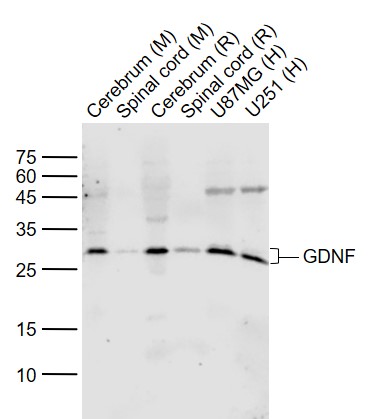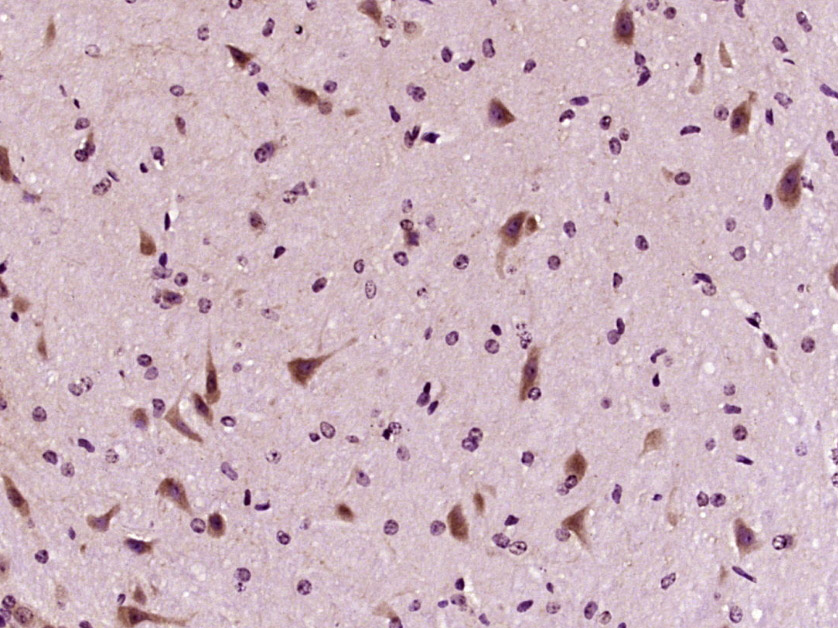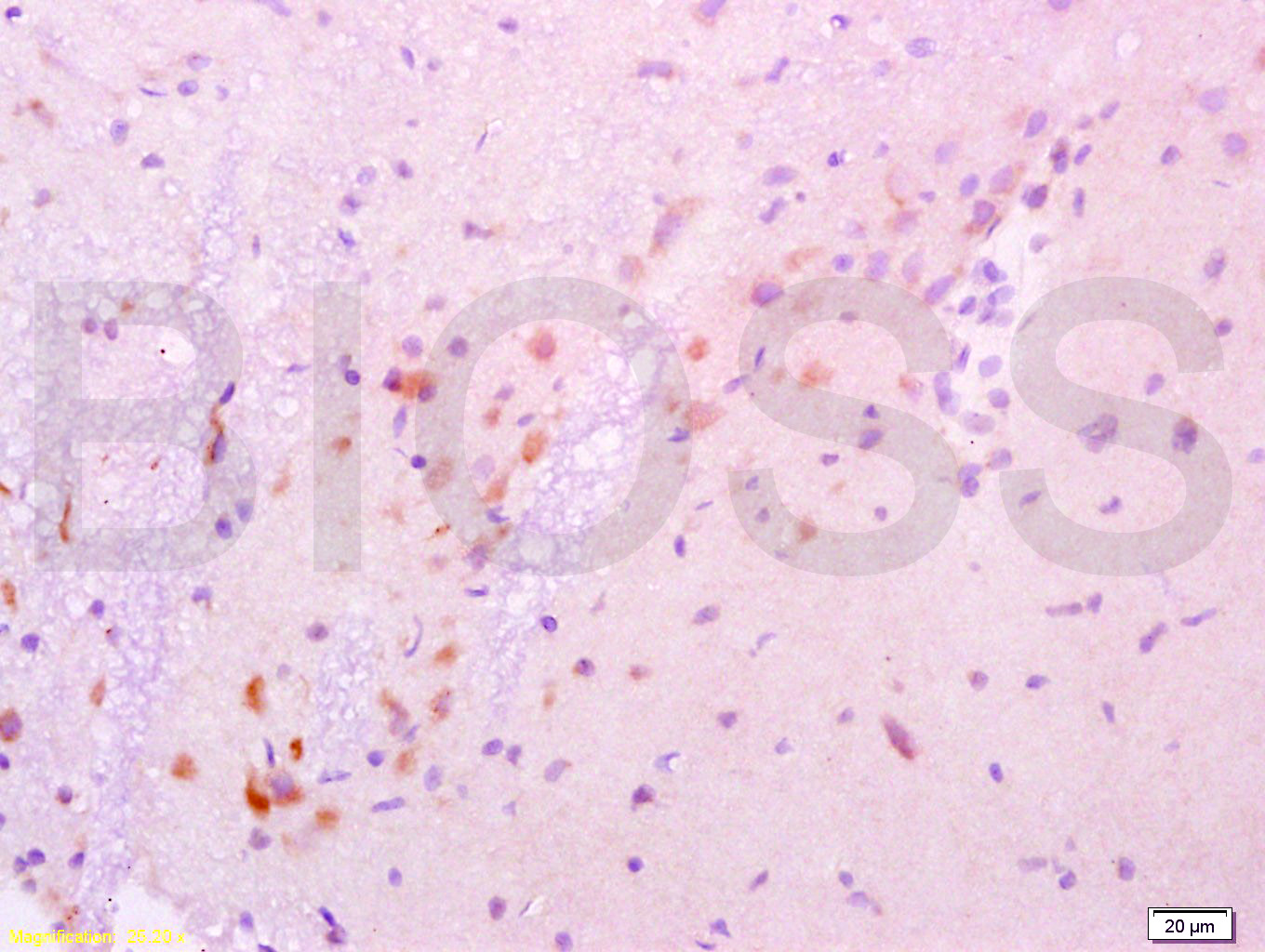
Rabbit Anti-GDNF antibody
glial cell line derived neurotrophic factor; Astrocyte derived trophic factor 1; Astrocyte derived trophic factor; ATF 1; ATF 2; ATF1; ATF2; Glial cell derived neurotrophic factor; Glial derived neurotrophic factor; HFB1 GDNF; GDNF_HUMAN; Atf; gdnf; Glial
View History [Clear]
Details
Product Name GDNF Chinese Name 胶质细胞源性神经营养因子抗体 Alias glial cell line derived neurotrophic factor; Astrocyte derived trophic factor 1; Astrocyte derived trophic factor; ATF 1; ATF 2; ATF1; ATF2; Glial cell derived neurotrophic factor; Glial derived neurotrophic factor; HFB1 GDNF; GDNF_HUMAN; Atf; gdnf; Glial Cell Line Derived Neurotrophic Factor; Glial cell line-derived neurotrophic factor; Glial derived neurotrophic factor; hGDNF; HSCR3. literatures Research Area Neurobiology Apoptosis Growth factors and hormones Immunogen Species Rabbit Clonality Polyclonal React Species Human, Mouse, Rat, (predicted: Chicken, Dog, Pig, Cow, Horse, Rabbit, ) Applications WB=1:500-2000 ELISA=1:5000-10000 IHC-P=1:100-500 IHC-F=1:100-500 IF=1:200-800 (Paraffin sections need antigen repair)
not yet tested in other applications.
optimal dilutions/concentrations should be determined by the end user.Theoretical molecular weight 15kDa Cellular localization Secretory protein Form Liquid Concentration 1mg/ml immunogen KLH conjugated synthetic peptide derived from human GDNF: 121-211/211 Lsotype IgG Purification affinity purified by Protein A Buffer Solution 0.01M TBS(pH7.4) with 1% BSA, 0.03% Proclin300 and 50% Glycerol. Storage Shipped at 4℃. Store at -20 °C for one year. Avoid repeated freeze/thaw cycles. Attention This product as supplied is intended for research use only, not for use in human, therapeutic or diagnostic applications. PubMed PubMed Product Detail Neurobiology. Neurotrophins. Neuroscience.
This gene encodes a highly conserved neurotrophic factor. The recombinant form of this protein was shown to promote the survival and differentiation of dopaminergic neurons in culture, and was able to prevent apoptosis of motor neurons induced by axotomy. The encoded protein is processed to a mature secreted form that exists as a homodimer. The mature form of the protein is a ligand for the product of the RET (rearranged during transfection) protooncogene. In addition to the transcript encoding GDNF, two additional alternative transcripts encoding distinct proteins, referred to as astrocyte-derived trophic factors, have also been described. Mutations in this gene may be associated with Hirschsprung disease.
Function:
Neurotrophic factor that enhances survival and morphological differentiation of dopaminergic neurons and increases their high-affinity dopamine uptake.
Subunit:
Homodimer; disulfide-linked.
Subcellular Location:
Secreted.
Tissue Specificity:
In the brain, predominantly expressed in the striatum with highest levels in the caudate and lowest in the putamen. Isoform 2 is absent from most tissues except for low levels in intestine and kidney. Highest expression of isoform 3 is found in pancreatic islets. Isoform 5 is expressed at very low levels in putamen, nucleus accumbens, prefrontal cortex, amygdala, hypothalamus and intestine. Isoform 3 is up-regulated in the middle temporal gyrus of Alzheimer disease patients while isoform 2 shows no change.
DISEASE:
Defects in GDNF may be a cause of Hirschsprung disease type 3 (HSCR3) [MIM:613711]. In association with mutations of RET gene, defects in GDNF may be involved in Hirschsprung disease. This genetic disorder of neural crest development is characterized by the absence of intramural ganglion cells in the hindgut, often resulting in intestinal obstruction.
Defects in GDNF are a cause of congenital central hypoventilation syndrome (CCHS) [MIM:209880]; also known as congenital failure of autonomic control or Ondine curse. CCHS is a rare disorder characterized by abnormal control of respiration in the absence of neuromuscular or lung disease, or an identifiable brain stem lesion. A deficiency in autonomic control of respiration results in inadequate or negligible ventilatory and arousal responses to hypercapnia and hypoxemia.
Similarity:
Belongs to the TGF-beta family. GDNF subfamily.
SWISS:
P39905
Gene ID:
2668
Database links:Entrez Gene: 2668 Human
Entrez Gene: 14573 Mouse
Omim: 600837 Human
SwissProt: P39905 Human
SwissProt: P48540 Mouse
Unigene: 248114 Human
Unigene: 4679 Mouse
Unigene: 53970 Rat
Neurobiology相关蛋白Product Picture
Lane 1: Cerebrum (Mouse) Lysate at 40 ug
Lane 2: Spinal cord (Mouse) Lysate at 40 ug
Lane 3: Cerebrum (Rat) Lysate at 40 ug
Lane 4: Spinal cord (Rat) Lysate at 40 ug
Lane 5: U87MG (Human) Cell Lysate at 30 ug
Lane 6: U251 (Human) Cell Lysate at 30 ug
Primary: Anti-GDNF (SL1024R) at 1/1000 dilution
Secondary: IRDye800CW Goat Anti-Rabbit IgG at 1/20000 dilution
Predicted band size: 25/20 kD
Observed band size: 28 kD
Paraformaldehyde-fixed, paraffin embedded (Mouse brain); Antigen retrieval by boiling in sodium citrate buffer (pH6.0) for 15min; Block endogenous peroxidase by 3% hydrogen peroxide for 20 minutes; Blocking buffer (normal goat serum) at 37°C for 30min; Antibody incubation with (GDNF) Polyclonal Antibody, Unconjugated (SL1024R) at 1:400 overnight at 4°C, followed by operating according to SP Kit(Rabbit) (sp-0023) instructionsand DAB staining.Paraformaldehyde-fixed, paraffin embedded (rat spinal cord); Antigen retrieval by boiling in sodium citrate buffer (pH6.0) for 15min; Block endogenous peroxidase by 3% hydrogen peroxide for 20 minutes; Blocking buffer (normal goat serum) at 37°C for 30min; Antibody incubation with (GDNF) Polyclonal Antibody, Unconjugated (SL1024R) at 1:200 overnight at 4°C, followed by operating according to SP Kit(Rabbit) (sp-0023) instructionsand DAB staining.Tissue/cell: rat brain tissue; 4% Paraformaldehyde-fixed and paraffin-embedded;
Antigen retrieval: citrate buffer ( 0.01M, pH 6.0 ), Boiling bathing for 15min; Block endogenous peroxidase by 3% Hydrogen peroxide for 30min; Blocking buffer (normal goat serum,C-0005) at 37℃ for 20 min;
Incubation: Anti-GDNF Polyclonal Antibody, Unconjugated(SL1024R) 1:200, overnight at 4°C, followed by conjugation to the secondary antibody(SP-0023) and DAB(C-0010) staining
Bought notes(bought amounts latest0)
No one bought this product
User Comment(Total0User Comment Num)
- No comment






 +86 571 56623320
+86 571 56623320
 +86 18668110335
+86 18668110335

